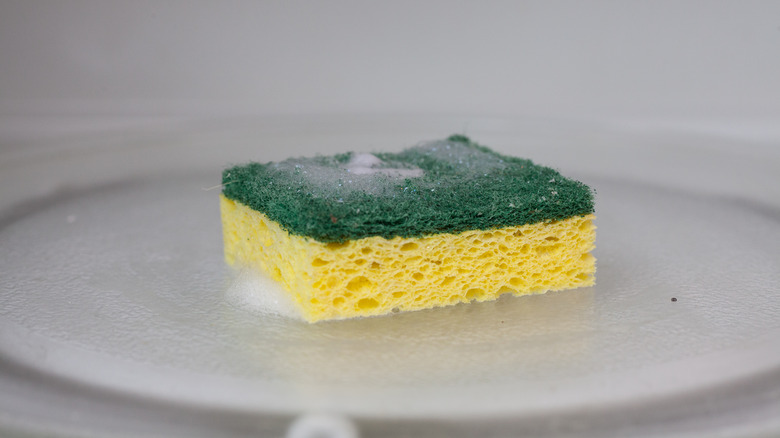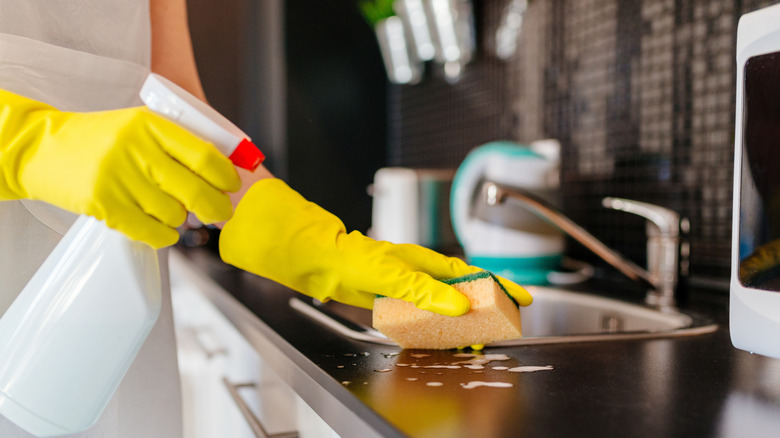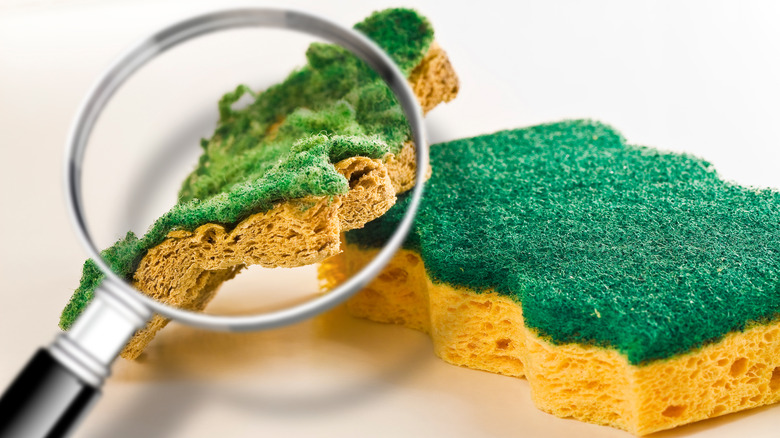Microwaving Your Sponge Does Way More Harm Than Good
We all want to keep our homes tidy, clean, and free from germs. Regularly cleaning and disinfecting are necessary for killing bacteria and viruses that can linger on surfaces and make us sick. And while most of us probably already know it is important to disinfect commonly touched surfaces in our homes that attract a lot of germs, like toilets, sinks, and doorknobs, germs can be hiding in some unlikely places. While we might think that the bathroom is likely the dirtiest room in the house, it turns out most of the germs in your house might actually be hiding in your kitchen.
In fact, "in most cases, it's safer to make a salad on a toilet seat than it is to make one on a cutting board," microbiologist Dr. Charles Gerba told Food & Wine. Most people know they need to sanitize the bathroom regularly but might not realize just how many germs are lingering in the kitchen, making it a haven for disease-causing bacteria and viruses. Kitchens are home to a number of common bacteria, including "E.coli, salmonella, shigella, campylobacter, norovirus and hepatitis A," which can spread from food "to other surfaces and potentially cause illness," infectious disease specialist Dr. Susan Rehm explained to the Cleveland Clinic.
Kitchen sponges harbor a lot of bacteria
So how can one eradicate these potentially illness-causing bacteria in the kitchen? A good start, of course, is to regularly wipe down and sanitize with disinfectant any surfaces in your kitchen that might come into contact with bacteria from food, like counters, cutting boards, and sinks, as well as any places that are commonly touched, such as oven and refrigerator handles and faucets. But while cleaning and sanitizing surfaces is always a good idea, germs can also linger in small, unexpected places.
According to Dr. Charles Gerba, who conducted research using 1,000 sponges and dishcloths, "about ten percent had salmonella. They get wet and stay moist, so bacteria grow like crazy. The most E. coli and other fecal-based bacteria in the average home are on a sponge or cleaning cloth" (via Food & Wine). That's right — the sponge that you use to clean your kitchen could be the dirtiest thing in the whole place. A recent study published in Scientific Reports reported that kitchen sponges "were proven to represent the biggest reservoirs of active bacteria in the whole house." So we know it is important to clean and sanitize our sponges regularly. However, the right way to get rid of bacteria build-up your sponge might not be what you think it is.
Microwaving sponges leaves the strongest bacteria behind
It has long been common advice that the best way to get rid of germ build-up on kitchen sponges is by tossing them in the microwave or dishwasher. The high heat can kill bacteria and even get rid of odors, making it a much more cost-effective solution than simply replacing your sponge every time it gets a little dingy, per Healthline. However, according to a recent study, that may be doing more harm than good.
It turns out that, while microwaving sponges will kill off some bacteria, it leaves behind the strongest strains that are more likely to potentially cause disease. These strong strains can colonize your sponge, making it an even more densely packed bacteria-filled environment than ever before. "Data showed that regularly sanitized sponges (as indicated by their users) did not contain less bacteria than uncleaned ones," because "presumably, resistant bacteria survive the sanitation process and rapidly re–colonize the released niches until reaching a similar abundance as before the treatment," the study reports, concluding that it's best to replace the sponge rather than trying to sanitize it.
If avoiding bacteria, germs, and viruses is at the top of your list, it might be worth spending a couple of extra bucks twice a month (per Martha Stewart) to replace your old sponge with a germ-free one.


